You’ve been in those faculty meetings where colleagues scroll their phones, avoid eye contact, or murmur about last month’s copier jam. Some are mentally revising lesson plans, others focused solely on their classrooms, disconnected from the group. Sound familiar? This isolation stalls team building efforts, leaving staff members craving real connection.
Many schools assume mandatory meetings create a successful team, but that’s off the mark. A research from Red Dragon Education shows that 70% of teachers report feeling isolated from their colleagues.
Why does this matter? Strong teams don’t just make the work environment warmer, they drive student success. Another study from the Lindenwood University Study (Missouri) found that schools with highly collaborative teaching staff see 23% higher student test scores and 19% better classroom management outcomes.
Team building activities, designed for educators, build communication skills, creative problem solving, and teamwork, uniting staff into a good team.
What makes this guide unique is that every team building activity is tested in real schools, respecting teachers’ expertise, which, by the way, strengthens trust. We’ve organized 20 effective team building activities into seven categories, covering icebreaker games, collaborative problem-solving, trust-building exercises, professional development, outdoor and physical activities, appreciation and recognition, and virtual or hybrid activities, each targeting specific team goals.
These team building exercises, with practical tips, time estimates, and classroom connections, deliver results in a fun way.
Ready to run team building sessions that transform your school? Let’s get started on these team building activities.
Activity /Summary Table
| Activity | الوقت | Group Size | Materials |
| Two Truths and a Lie | 20-25 min | 8-16 | None |
| Human Bingo | 15-20 min | 15+ | Bingo cards, pens |
| Escape Room Challenge | 60-90 min | 4-8 | Puzzles, props |
| Marshmallow Challenge | 25-30 min | 4-5 | Spaghetti, tape, string, marshmallow |
| Trust Falls | 15-20 min | Pairs/3-4 | Mats |
| Back-to-Back Drawing | 20-25 min | Pairs | Paper, pencils, diagrams |
| Human Knot | 15-20 min | 8-12 | None |
| Lesson Plan Swap | 45-60 min | Pairs/3-4 | Templates, feedback forms |
| Peer Observations | 65 min | Pairs | Protocols, reflection forms |
| Feedback Carousel | 90-120 min | 12-20 | Displays, feedback forms |
| Geocaching | 2-3 hr | 4-6 | Smartphones, notebooks |
| Field Day Relays | 2-3 hr | 15+ | Cones, ropes, balls |
| Outdoor Yoga | 45-60 min | 10-25 | Mats, speaker |
| Gratitude Jar | 2-5 min | Any | Jar, note cards, pens |
| Memory Wall | 30-45 min | 10-20 | Sticky notes, pens, board |
| Peer Awards | 35 min | 8+ | Voting platform, certificates |
| Thank-You Video | 4-5 hr | Any | Camera, editing software |
| Online Pictionary | 30-45 min | 6-12 | Internet, drawing device |
| Digital Escape Rooms | 60-90 min | 4-6 | Video platform, puzzles |
| Mindfulness Breaks | 5-7 min | Any | None |
Icebreaker Games
Have you ever walked into a staff meeting where everyone feels like a stranger, despite sharing a building for years? Schools often rely on name tags or awkward “fun facts,” but those fall flat for team building. Great team building games break down walls, connecting team members through shared stories, which encourages creative thinking.
These quick team building activities, ideal for small groups or the entire team, can add color and warmth.
Below are two team building games that make team building sessions unforgettable.
1. Two Truths and a Lie: Educator Edition
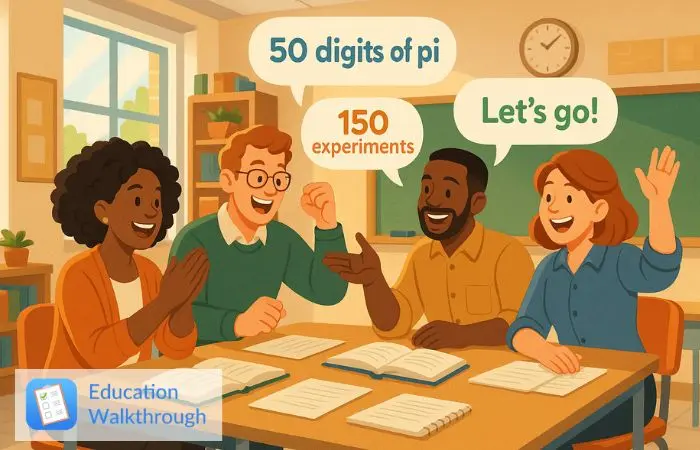
You’ve probably played this team building game, but here’s a version that stands out for teachers. Each team member shares three statements about their teaching, two truths, one lie, and colleagues guess the lie. The key is focusing on professional stories, which helps teachers communicate effectively and build respect.
With this, your colleague might grin as she shares: “I had a student memorize 50 digits of pi,” “I’ve created 150 hands-on experiments,” and “My faculty meeting lasted five hours.” Of course, the room is charged with excitement as everyone debates, learning her passion for labs. You’ll see new team members relax as veterans share quirky tales.
Time: 20-25 minutes
Group Size: 8-16 (split larger groups)
Materials: None
This fun team building activity takes just a few minutes but creates lasting bonds. Facilitators can model detailed stories, asking, “What sparked those experiments?” Try variations: classroom wins, subject expertise, or new teams’ backgrounds. For remote teams, Google Forms collects submissions, adding tech skills. Parents can even guess teachers’ stories at open houses, joining the fun and building community.
2. Human Bingo: Uncovering Hidden Talents

Almost every teacher has skills beyond their subject, but their colleagues rarely know them. I bet you were surprised when you discovered that the quiet math teacher speaks four languages or that the PE instructor is a published poet.
Human Bingo, a lively team building game, uncovers these, encouraging open communication.
Create bingo cards with squares like:
- “Has lived in another country”
- “Plays a musical instrument”
- “Speaks more than two languages”
- “Has published writing”
- “Coaches a sport outside school”
- “Has a side business”
- “Volunteers for a nonprofit”
- “Has performed on stage”
That way, team members mingle, finding matches and learning details that are useful for starting real conversations.
Time: 15-20 minutes
Group Size: 15+
Materials: Bingo cards, pens
This quick team building activity doubles as job training, revealing skills for teamwork. Add school-specific squares like “Survived the 2023 tech outage” or prizes for five-in-a-row. You can also tailor cards to certifications or elementary school quirks. Not just that, you can share downloadable templates in your CTA which parents can play at PTA nights, learning teachers’ talents, which supports collaboration.
Now, let’s discuss problem-solving team building exercises.
Collaborative Problem-Solving
If you’ve sat through “collaborative” meetings where half the team mentally plans lessons, you know that’s not real team building. Real collaboration means tackling challenges together, just like teaching requires. Team building exercises focus on creative problem solving, sharpening problem solving skills, and preparing staff for planning or crises.
As a matter of fact, research from the Journal of Education and Health Promotion shows that collaborative problem-solving activities improve interpersonal communication, critical thinking, and teamwork skills significantly more than traditional team meetings. These team building activities engage the entire team, making teams work smarter.
Here are two that turn small teams into strategic champs.
3. Escape Room Challenge: Cracking the Code
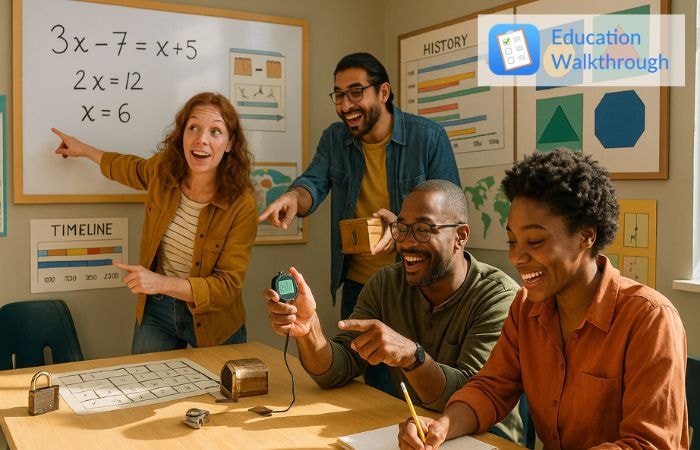
An escape room team building activity brings ‘that’ energy, with small groups racing a 60-minute clock to solve education-themed puzzles and ‘escape.’ Your PE coach might tackle a timeline puzzle, while the librarian decodes a literature riddle, their laughter filling the room as they succeed.
But this isn’t just fun and games.
A study on escape room clinical evaluation published in PubMed found that 80% of participants rated escape room challenges as satisfactory or highly satisfactory for building teamwork skills, with 72% reporting improved preparedness for collaborative work.
Here is how to implement it:
Setup:
- Physical: Turn a classroom into a puzzle hub (e.g., unlock lesson plans).
- Virtual: Use Breakout EDU on Zoom.
Puzzles:
- Solve math clues for keys.
- Decode historical timelines.
Time: 60-90 minutes
Group Size: 4-8
Materials: Puzzles, props
Checklist:
- Run team building exercises with classroom themes.
- Test puzzles for clarity.
- Assign roles (team leader, note-taker).
However, there’s more.
The research on escape rooms and critical thinking from Sherlocked explains that escape rooms specifically “challenge your mental processes” and force participants to “assess situations and find effective solutions quickly and efficiently.”
Pro implementation tips:
- Start with easier puzzles to build confidence before increasing difficulty.
- Include multiple solution paths so different thinking styles can contribute.
- Create roles: designate a timekeeper, note-taker, and communications coordinator.
- Debrief immediately: discuss how the problem-solving process mirrors real classroom challenges.
Troubleshooting common issues:
- Did your team get stuck? Provide graduated hints every 10-15 minutes.
- One person dominates? Require rotation of leadership for every puzzle.
- Technology fails? Have backup paper-based puzzles ready.
School committees are not left out as they can fund props, showing employee engagement. Parents can also volunteer as clue designers as a great way to join team building in a classroom setting.
4. Marshmallow Challenge: Building with Heart

We’ve all had lessons flop mid-class, forcing a quick pivot. And that’s what the Marshmallow Challenge, another team building exercise, captures.
Research from Employee Engagement Trends shows that this challenge “encourages participants to communicate efficiently, make quick decisions, and adapt their strategy if the initial approach isn’t working.”
How does it work? Small teams use only the items spaghetti, tape, string, and a marshmallow to build a tall structure, marshmallow on top. More often than not, different towers will collapse, with each team suggesting new ideas on how to win.
The setup is quite straightforward:
- 20 spaghetti, 1 yard tape, 1 string, 1 marshmallow.
- 18 minutes; silent first 5 minutes.
Time: 25-30 minutes
Group Size: 4-5
Materials: Spaghetti, tape, string, marshmallow
As great as this seems, most teams often overbuild, then realize that the marshmallow is heavy. Some of the mistakes in real time include overplanning lessons, learning to prototype fast, which is not entirely bad. Instead, try these winning strategies:
- Start with the marshmallow: Test your “student engagement” first.
- Build in iterations: Create small prototypes before the final lesson.
- Embrace failure fast: If something doesn’t work, pivot quickly.
- Use diverse perspectives: Every team member brings different strengths.
Some advanced facilitation techniques also includes:
- Round 1: Standard challenge (18 minutes).
- Round 2: Add constraints like “budget” (limit tape usage) or “accessibility” (one person works blindfolded).
- Round 3: Teams combine resources to build one mega-structure.
Debrief questions that connect to teaching:
- “How did you test your ideas before committing to them?”
- “When did you realize your initial plan wasn’t working?”
- “How could this process improve your lesson planning?”
Trust-Building Exercises
Trust doesn’t grow just because staff members share a lounge. It needs intentional team building to create a safe space for sharing, which, by the way, supports teamwork. These team building exercises, strengthening listening skills and non-verbal communication, build stronger teams. Here are three to bring your team closer.
5. Trust Falls: Relying on Each Other
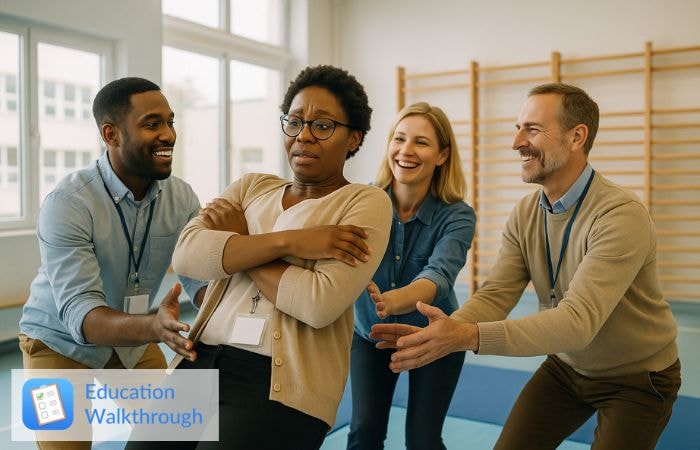
Here’s the uncomfortable truth about teacher collaboration: Most schools think trust happens automatically when you put professional educators in the same building.
Newsflash, It doesn’t.
In fact, research from the University of Calgary reveals that trust in educational settings has four distinct dimensions, which are: cognition-based, affect-based, identity-based, and values-based, and building genuine trust requires intentional, structured activities that address each area.
These trust-building exercises also help develop listening skills among teachers, promoting active listening and understanding within the team.
But here’s what most administrators don’t realize. Trust isn’t just nice to have, it’s the foundation of every high-performing teaching team.
Google’s Project Aristotle research found that psychological safety (which is built on trust) was the single most important factor in team effectiveness.
Think about it. How can teachers collaborate on curriculum, share vulnerable classroom struggles, or give each other honest feedback without a foundation of genuine trust?
Trust falls may seem classic, but they’re powerful team building activities. This is what research has to say. A study on trust-building activities published in education research found that physical trust exercises like trust falls create immediate, measurable increases in team cohesion because they require “authentic vulnerability and mutual dependence.”
This activity is incredibly easy. One team member falls backward, eyes closed, trusting colleagues to catch them. At first, a shy teacher might hesitate, then smile wide when caught, feeling the team’s support.
Time: 15-20 minutes
Group Size: Pairs/3-4
Materials: Mats
After all is done, ask:
- “Who supports you on tough teaching days?”
- “How does this activity reflect team support?”
Just as Education Northwest study on trust building notes, “building new relationships takes time, but when trust exercises are properly facilitated, they create immediate foundations for deeper collaboration.”
6. Back-to-Back Drawing: Communication Under

Pressure
Every teacher is familiar with this frustration. You’re explaining a concept perfectly clearly (in your mind), but students look at you like you’re speaking ancient Greek.
Back-to-Back Drawing solves this problem by forcing teachers to experience communication from both sides.
Research from Participatory Methods shows that this exercise “develops effective communication, active listening, and questioning skills” while highlighting “the importance of detail in communication.”
How it works:
- Pairs sit back-to-back (can’t see each other).
- One person has a simple drawing or diagram.
- They must describe it so their partner can recreate it exactly.
- No peeking allowed until the drawing is complete.
- Compare results and switch roles.
Time commitment: 20-25 minutes (two rounds plus debrief).
Group size: Any even number (pairs)
Materials needed: Simple drawings/diagrams, blank paper, pencils.
Educational-specific image suggestions:
- Classroom layout diagrams: Desk arrangements, learning centers.
- Lesson flow charts: Sequential steps in a teaching process.
- Student grouping configurations: How to arrange collaborative learning.
- Assessment rubric visuals: Simple graphic organizers.
This mirrors the exact challenge teachers face when giving instructions to students. The exercise also helps teams practice working toward common team goals through clear communication.
Advanced facilitation techniques:
- Round 1: Use educational diagrams (classroom layouts, lesson sequences)
- Round 2: Add time pressure to simulate real classroom urgency
- Round 3: Include “student interruptions” (facilitator adds distractions)
Processing questions that matter:
- “When did you realize your instructions weren’t clear?”
- “How did this feel similar to explaining concepts to students?”
- “What strategies helped you ask better clarifying questions?”
- “How could this improve parent-teacher conference communication?”
Virtual adaptation: Use breakout rooms where one person shares their screen with the image while the other draws on a digital whiteboard or paper, showing results on camera.
Skills that transfer directly to teaching:
- Checking for understanding: Learning when to pause and clarify
- Descriptive language: Using precise vocabulary for complex ideas
- Student perspective: Understanding confusion from the learner’s side
- Patience with repetition: Recognizing that clear communication takes time
Put all of these together and you would have built listening skills in a fun way.
7. Human Knot: Untangling Together

The Human Knot, a lively team building game, has team members stand in a circle, hands tangled, untangling without breaking grip. Carrying out this activity is a great time for your team to bond as they laugh through the process, solving the knot, feeling like a successful team.
Time: 15-20 minutes
Group Size: 8-12
Materials: None
This team building activity encourages creative thinking. While at it, ensure to set clear safety rules. Afterwards, consider debriefing with a question like: “How did you delegate tasks?”
Now, let’s explore professional development team building activities.
التطوير المهني
Professional development often feels like a disconnected chore for most teachers. Every now and then, teachers sit in sessions about “innovative teaching strategies” led by people who haven’t been in a classroom for years, listening to theory that has little connection to Monday morning reality. It’s no surprise that traditional PD doesn’t work.
What then works? It’s often the overlooked job-embedded, collaborative team building activities, which by the way, increases teacher effectiveness by 45% and student achievement by 21%, as backed up by research.
Here are three that deliver.
8. Lesson Plan Swap: Peer Reviews That Actually Improves Teaching
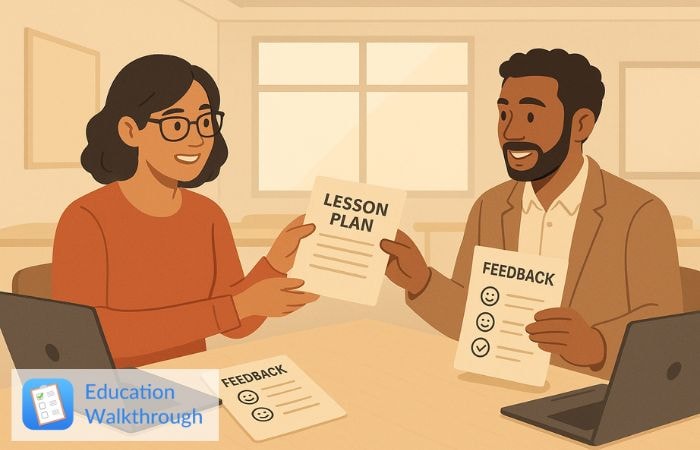
What most schools fail to realize is this. A great lesson plan can still fail without feedback. Lesson Plan Swap, a team building activity, lets pairs review plans, refining them with a protocol. What’s more? New ideas are shared and interactive sessions are opened up.
Consider this:
- Teachers submit lesson plans 48 hours before teaching them.
- Pairs or small groups review plans using structured feedback protocols.
- Focus on specific elements: student engagement, differentiation, assessment alignment.
- Reviewers provide written feedback and meet for 15-minute discussions.
- Plan creators implement suggestions and report back on results.
Time: 45-60 minutes
Group Size: Pairs/3-4
Materials: Templates, the benefits of classroom walkthroughs, feedback forms, meeting place
Protocol:
- Glow: Share a strength.
- Grow: Suggest a tweak.
- Goal: Reflect.
What makes this different from traditional peer review?
- Voluntary participation: Teachers choose their feedback partners based on trust and expertise.
- Implementation focus: Emphasis on practical improvements rather than theoretical critique.
- Reciprocal learning: Everyone gives and receives feedback, creating mutual professional growth.
- Outcome tracking: Success measured by student engagement and achievement, not compliance.
To get the most out of this activity, adapt for elementary school (centers) or secondary (tech), with Google Docs aids real-time edits. At the end, your debrief should look like this: “How did this feedback help?”
9. Peer Observations: Real Classroom Learning in Action
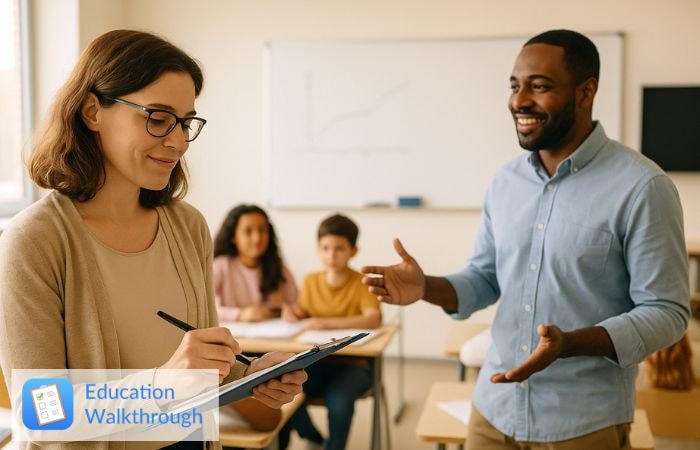
Peer observations can feel like judgment, especially when they are used for just evaluation, rather than education.
So, what does this activity entail?
- Teachers invite colleagues to observe specific aspects of their teaching.
- Observers use structured protocols focused on the requested feedback area.
- Post-observation conversations happen within 24-48 hours.
- Both observer and observed teacher reflect on insights gained.
Peer observations provide valuable insights into effective teaching practices in the classroom setting, allowing educators to see real-world strategies and collaboration in action.
Time commitment: 45 minutes observation + 20 minutes debrief
Group size: Pairs (observer and observed)
Materials needed: Observation protocol, reflection forms, coverage for observing teacher
Observation focus areas that drive improvement:
- Student engagement strategies: How does the teacher maintain attention and motivation?
- Differentiation techniques: How are diverse learning needs addressed?
- Questioning strategies: What types of questions promote deeper thinking?
- Classroom management: How does the teacher maintain a positive learning environment?
- Technology integration: How effectively are digital tools used to enhance learning?
Structured observation protocols:
- Pre-observation conversation: What should I look for? What challenges are you facing?
- During observation: Objective notes on requested focus area plus student responses
- Post-observation reflection: What did you notice? What questions arose? What ideas emerged?
Cross-departmental benefits:
Educators can benefit greatly from walkthroughs and informal observations as learning opportunities:
- Elementary observing secondary: Learn advanced questioning techniques and content expertise.
- Secondary observing elementary: Discover engagement strategies and differentiation methods.
- Special education observing general education: Share accommodation strategies and behavior management.
- New teachers observing veterans: Gain practical classroom management and instructional techniques.
For a comprehensive list of what to look for during classroom observations, check out the top 50 look-fors during classroom observations.
Implementation strategies that ensure success:
- Voluntary basis: Teachers choose when and who observes them.
- Reciprocal arrangements: Everyone participates as both observer and observed.
- Confidential feedback: Observations remain between participating teachers.
- Administrative support: Principals provide coverage but don’t require reports.
Advanced techniques for deeper learning:
- Video analysis: Record lessons (with permission) for multiple viewings and detailed analysis.
- Student interviews: Ask students about their learning experience during observed lessons.
- Co-teaching experiments: Observers join as teaching partners for specific activities.
- Focus cycles: Multiple observations targeting the same instructional challenge over time.
Peer observation programs that concentrate on specific instructional practices and incorporate structured feedback conversations often lead to lasting improvements in teaching and better student outcomes.
10. Feedback Carousel: Structured Peer Inputs on Professional Projects

Most teachers work in isolation, never getting feedback on their creative projects until they’re already implemented, and sometimes failing, in the classroom.
Feedback Carousel changes that by creating structured opportunities for peer input before teachers invest significant time and energy in new initiatives.
Research from Harvard Business School shows that teams using structured feedback processes improve project quality by 23% and reduce implementation time by 31%.
The rotating station setup:
- Teachers set up stations displaying their work-in-progress projects.
- Small groups rotate through stations, spending 15 minutes at each.
- Feedback providers use structured protocols to give specific, actionable input.
- Project creators receive multiple perspectives without feeling overwhelmed.
Time commitment: 90-120 minutes total
Group size: 12-20 teachers (3-4 people per feedback group)
Materials needed: Table space for displays, feedback forms, timers, poster paper
Projects perfect for feedback carousel:
- Unit plans in development: Scope and sequence, essential questions, assessment alignment.
- Classroom redesign proposals: Physical layout changes, learning center organization.
- Student engagement initiatives: Behavior systems, motivation strategies, gamification plans.
- Technology integration projects: New platform implementations, digital tool adoption.
- Parent communication systems: Newsletter formats, conference structures, home-school partnerships.
Structured feedback protocol that prevents overwhelm:
- Stars (2 minutes): What’s working well? What strengths do you see?
- Questions (5 minutes): What clarifications would help you understand the project better?
- Suggestions (5 minutes): What specific improvements or alternatives could you recommend?
- Next steps (3 minutes): What should the creator prioritize for the next development phase?
Advanced facilitation techniques:
- Role assignments: Designate different group members to focus on different feedback areas
- Silent start: Begin each station with 3 minutes of silent review before discussion
- Creator guidelines: Project owners listen without defending for first 10 minutes
- Documentation system: Feedback forms stay with projects for creator reference
Benefits specific to educators:
- Multiple perspectives: Different grade levels and subjects provide diverse insights
- Time efficiency: Receive several rounds of feedback in single session
- Reduced defensiveness: Structured format keeps feedback constructive and specific
- Implementation planning: Feedback helps identify potential challenges before they occur
Variations for different project types:
- Lesson plan carousel: Focus on engagement, differentiation, and assessment strategies.
- Technology showcase: Hands-on exploration of new digital tools and platforms.
- Student work analysis: Collaborative examination of assessment data and student samples.
- Behavior intervention planning: Problem-solving around challenging student situations.
At the end of this exercise, you’ll find that structured feedback processes not only improve project outcomes but also increase team member satisfaction and collaborative relationships.
Outdoor/Physical Activities
Have you ever considered when was the last time your teaching team moved their bodies together outside of walking to the parking lot? Teachers need physical activity to cut stress and boost creativity, not just students. These outdoor team building games energize team members, building bonds outside the classroom setting.
Don’t just take my word for it. Research from the American College of Sports Medicine shows that group physical activities increase team cohesion by 34% and improve collaborative problem-solving by 28%.
Here are three outdoor activities to fuel your inspiration:
11. Geocaching: Modern Treasure Hunting for Team Building
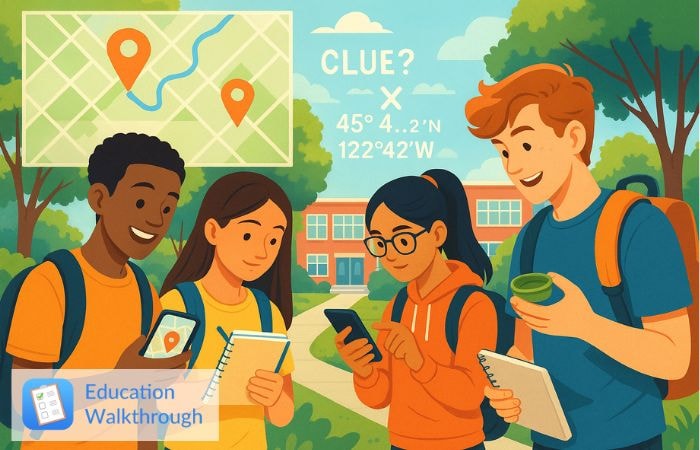
Take a second look at geocaching and you’ll soon find that it’s a creative problem solving partner in disguise. Here, teams hunt for “caches” with GPS apps, solving education-themed clues on campus.
Time: 2-3 hr
Group Size: 4-6
Materials: Smartphones, notebooks
Educational applications that make this relevant:
- Geography skills: Understanding coordinates, maps, and spatial relationships.
- Problem-solving practice: Interpreting clues and working through challenges together.
- Local community exploration: Discovering historical sites and community resources.
- Technology integration: Using GPS and mapping apps for educational purposes.
School-specific geocaching variations:
- Campus exploration: Hide caches in different areas of school grounds for new teacher orientation.
- Curriculum connections: Create clues related to subject-area content or school history.
- Student engagement planning: Use locations where teachers brainstorm ideas for outdoor learning.
- Community partnership building: Visit local businesses and community centers during searches.
Implementation strategies:
- Start simple: Begin with easy caches close to school before attempting challenging locations.
- Safety protocols: Establish boundaries and check-in procedures for off-campus activities.
- Reflection integration: Discuss teamwork strategies and communication patterns during searches.
- Documentation: Take photos at each location to create shared memories and discussion points.
Advanced geocaching techniques:
- Create your own caches: Teams design and hide caches for other groups to find.
- Multi-stage puzzles: Complex hunts requiring multiple stops and collaborative problem-solving, sometimes involving trivia questions.
- Educational themes: Focus searches around local history, environmental science, or community resources.
- Cross-school collaboration: Partner with other schools for inter-district geocaching events.
12. Field Day Relays: Reclaiming the Joy of Physical Play
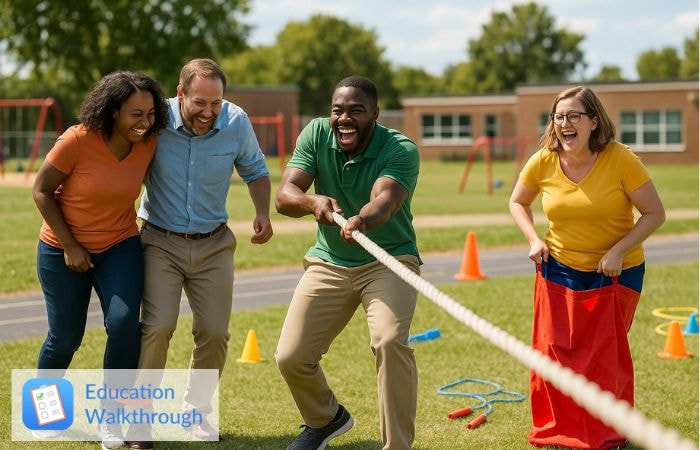
Every teacher remembers field day from their own elementary school experience; the excitement, the laughter, the friendly competition, and the pure joy of moving their body with classmates.
But when was the last time you experienced that as an adult?
This setup puts you on the right track:
- Mix classic field day activities with adult-appropriate challenges.
- Create teams that mix different grade levels and departments.
- Organize participants into equal teams to ensure balanced and fair competition.
- Focus on participation and fun rather than winning.
- Include activities that accommodate different fitness levels and physical abilities.
Time commitment: 2-3 hours including setup and celebration.
Group size: 15+ teachers (allows for multiple teams and activities).
Materials needed: Cones, ropes, sacks, balls, timers, prizes.
Activities that create maximum engagement:
- Three-legged race: Builds cooperation and communication under pressure.
- Sack races: Pure fun that levels the playing field regardless of athletic ability.
- Tug-of-war: Collaborative strength building with dramatic, exciting moments.
- Relay races: Strategic team building with multiple participants contributing.
- Obstacle courses: Problem-solving and mutual encouragement.
Teacher-specific adaptations:
- Lesson plan relay: Teams race to organize scattered lesson components in correct order.
- Supply scavenger hunt: Find and collect common classroom materials hidden around the area.
- Grade book balance: Carry stacks of papers through obstacle courses without dropping them.
- Classroom management challenge: Navigate obstacles while maintaining “student line” formation.
Implementation strategies that ensure inclusivity:
- Multiple difficulty levels: Offer modified versions for different physical abilities.
- Role rotation: Everyone participates but not necessarily in every physical activity.
- Celebration focus: Emphasize fun, effort, and teamwork over speed or strength.
- Photo documentation: Capture moments of joy and laughter for team building memories.
Why this works specifically for educators:
- Stress release: Physical activity provides natural antidote to classroom pressures.
- Level playing field: Athletic ability doesn’t correlate with teaching expertise.
- Shared vulnerability: Everyone looks slightly ridiculous, which builds humility and connection.
- Pure joy: Recaptures the playfulness that drew many people to work with children.
Advanced variations for sustained engagement:
- Seasonal themes: Fall harvest games, winter challenges, spring cleaning relays.
- Department competitions: Grade levels or subjects compete in friendly rivalry.
- Multi-school events: Partner with neighboring schools for larger competitions.
- Student involvement: Include student volunteers as judges, cheerleaders, or participants.
13. Outdoor Yoga: Collaborative Wellness and Stress Relief

If we are going to be honest, teaching is one of the most physically and emotionally demanding professions, but most schools offer zero support for teacher wellness.
Outdoor yoga changes that by providing immediate stress relief while building team connections through shared vulnerability and self-care practice.
According to research from Harvard Medical School, group yoga practice reduces cortisol levels by 41%, decreases anxiety by 32%, and improves workplace relationships by 28%.
How can you ensure what works for all levels?
- Choose level outdoor space (grass field, playground, or courtyard)
- Hire certified instructor or use experienced teacher on staff
- Focus on gentle, accessible poses that accommodate all fitness levels
- Emphasize stress relief and team building over perfect form
Time commitment: 45-60 minutes
Group size: 10-25 teachers (manageable for instruction and space)
Materials needed: Yoga mats or towels, portable speaker (optional), comfortable clothes
Some of the specific benefits that yoga practices offers teachers are:
- Neck and shoulder releases: Address tension from computer work and carrying materials
- Hip openers: Counter effects of sitting and standing for long periods
- Spinal twists: Release lower back tension from desk work and classroom stress
- Breathing exercises: Provide tools for managing classroom pressure and difficult moments
- Relaxation techniques: Practice strategies that can be used during busy school days
Teacher-specific adaptations:
- Chair yoga options: Modifications for teachers with mobility limitations or injuries
- Quick stress relief techniques: 5-minute practices that can be used during prep periods
- Classroom application: Breathing and stretching techniques teachers can share with students
- Mindfulness integration: Awareness practices that improve presence and patience in classroom
Implementation strategies that build community:
- Beginner-friendly focus: Emphasize that no previous experience is necessary
- Partner poses: Include collaborative postures that require trust and communication
- Sharing circles: Optional reflection time about stress management and self-care
- Regular scheduling: Weekly or monthly sessions to build sustained wellness practice
Advanced wellness integration:
- Meditation components: Include guided mindfulness practices for mental health
- Nature connection: Discuss how outdoor time can be integrated into personal wellness routines
- Student applications: Explore how yoga and mindfulness can support classroom management
- Home practice resources: Provide videos or guides for individual stress relief
Benefits specific to teaching profession:
- Physical relief: Addresses occupational hazards like back pain and repetitive stress
- Emotional regulation: Provides tools for managing difficult student or parent interactions
- Team vulnerability: Shared challenge creates bonds beyond professional relationships
- Modeling wellness: Teachers experience self-care they can then prioritize in their own lives
To top it off, Harvard Medical School study once again emphasized that group yoga practice provides unique benefits for stress reduction and social connection that individual practice cannot replicate.
Appreciation & Recognition
A coffee mug with “World’s Best Teacher” or a catered lunch during Teacher Appreciation Week will not magically solve morale problems. Even if it does, the results vapourize very quickly. Team building activities that celebrate team members often boost morale and create validation.
Consider these four:
14. Gratitude Jar: Building a Culture of Continuous Recognition

According to research on gratitude in the workplace, regular expressions of appreciation increase dopamine and serotonin levels, creating neurochemical changes that improve both individual well-being and team cohesion.
Follow these simple steps:
- Place a decorated jar in a central location with note cards nearby.
- Encourage specific, behavior-focused appreciation rather than generic praise. Try: “Your patience during math week inspired me.”
- Read 3-5 notes aloud during each staff meeting.
- Keep notes anonymous to reduce self-consciousness.
Time: 2-5 min
Group Size: Any
Materials: Jar, note cards, pens
For more results, include support staff and use a padlet for virtual notes. Parents can also jump on this by adding notes at open houses, which helps deepen team building.
15. Memory Wall: Shared Stories

A Memory Wall, where team members write shared moments on sticky notes, celebrates bonds. For example, you could share a note about a chaotic field trip turned triumph and you’ll soon find your teachers smiling widely.
Time: 30-45 min
Group Size: 10-20
Materials: Sticky notes, board
If you want to take things a notch higher, add QR codes to stories and encourage nominations on the moment that stood out the most.
16. Peer Awards: Recognizing Hidden Strengths
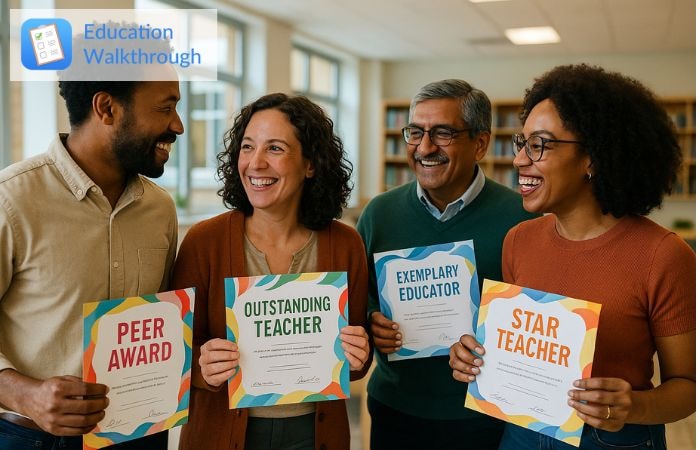
Traditional awards come from administrators who observe teachers sporadically and often miss the daily acts of excellence that colleagues witness firsthand.
Peer awards flip this dynamic by empowering teachers to recognize the strengths they see in action every day.
According to research on peer recognition systems, colleague-nominated awards have 67% higher perceived value than top-down recognition because they’re based on authentic, observed behaviors.
To maximize impact:
- Create 5-8 award categories that reflect diverse teaching strengths
- Use anonymous voting system to reduce politics and favoritism
- Present awards during formal staff meetings with specific examples
- Include small, meaningful tokens (certificates, gift cards, extra prep time)
Time commitment: 15 minutes for voting, 20 minutes for presentation ceremony
Group size: 8+ staff members (allows for meaningful voting pools)
Materials needed: Voting platform, certificates, small rewards
Award categories that celebrate diverse expertise:
- “Innovation Champion”: Most creative problem-solving or teaching techniques
- “Collaboration Catalyst”: Best at bringing teams together and facilitating cooperation
- “Student Whisperer”: Exceptional ability to connect with and motivate challenging students
- “Behind-the-Scenes Hero”: Quietly handles tasks that keep the school running smoothly
- “Growth Guru”: Most supportive of colleague professional development
- “Technology Trailblazer”: Leading adoption and integration of new digital tools
- “Wellness Warrior”: Promotes healthy work-life balance and stress management
- “Community Connector”: Builds strongest relationships with families and community members
Voting process that ensures fairness:
- Anonymous digital surveys: Use Google Forms or similar platforms
- Specific examples required: Voters must provide concrete instances of nominated behaviors
- Multiple winners: Allow ties and co-winners to avoid artificially limiting recognition
- Quarterly ceremonies: Frequent enough to maintain momentum, spaced enough to be special
Implementation strategies that build culture:
- Nomination stories: Share specific examples of why each winner was chosen
- Previous winner involvement: Past recipients help present current awards
- Photo documentation: Create visual record of celebrations for future reference
- Skills sharing: Award winners offer optional workshops sharing their expertise
The result of peer-nominated recognition is this. It increases both individual motivation and team cohesion because it validates behaviors that colleagues actually value one another through observation.
17. Thank-You Video: Emotional Reinforcement for Tough Times

Every teacher has moments when they question whether they’re making a difference; usually around 2 PM on a Wednesday in February when the copier is broken, the heater isn’t working, and half the class has forgotten their homework.
Thank-you videos provide emotional ammunition for exactly those moments.
Video messages from students and even parents can boost resilience. Imagine getting a: “Your math tips changed my kid’s confidence.” You’ll most likely tear up.
Time: 4-5 hr
Group Size: Any
Materials: Camera
Collection strategies that ensure authenticity:
- Prompt questions: “Tell us about a specific moment when this teacher made a difference”
- Natural settings: Record in classrooms, during activities, or informal moments
- Multiple attempts: Allow re-recording until messages feel genuine and comfortable
- Permission protocols: Clear consent for recording and sharing
Advanced production techniques:
- Professional editing: Use simple software like iMovie or Canva to add titles and music
- Surprise elements: Include unexpected contributors (former colleagues, retired teachers)
- Seasonal timing: Create videos for Teacher Appreciation Week, end of school year, or difficult periods
- Personal copies: Provide individual teachers with their specific messages for private viewing
Distribution strategies that maximize impact:
- Faculty meeting premieres: Watch together for shared emotional experience
- Digital archives: Create lasting library that teachers can access anytime
- Crisis support: Share during particularly challenging periods or personal difficulties
- New teacher orientation: Show examples of long-term impact to inspire newcomers
Virtual/Hybrid Activities
If there is anything that remote teams have taught us, it’s the fact that meaningful connections can happen through screens, if you know how to create them. Virtual meetings can be tiring, with some feeling like their time is being wasted, and others getting distracted at the slightest inconvenience.
Several virtual team building activities bridge the gap by ensuring that connections are kept strong no matter what. Some of them are:
18. Online Pictionary: Competitive Fun That Builds Bonds

Stop trying to replicate in-person activities, you’ll be making a huge mistake by doing that. Instead, leverage what digital platforms do best. With Online Pictionary, you can use technology to create engagement that’s actually more dynamic than the physical version.
To kick off, consider these platforms:
- Skribbl.io: Free, intuitive, perfect for quick sessions
- Gartic Phone: Combines drawing with storytelling for extended engagement
- Zoom whiteboard: Built-in option for teams already using Zoom
- Google Jamboard: Integrates well with Google Workspace schools
Time: 30-45 min
Group Size: 6-12
Materials: Internet
Educational twist that adds meaning:
- Subject-specific words: Math terms, science concepts, historical figures
- School-related prompts: Classroom management scenarios, teaching tools, student behaviors
- Professional development themes: Educational theorists, teaching strategies, assessment methods
- Grade-level appropriate content: Vocabulary and concepts relevant to specific teams
Game variations that maintain interest:
- Team competitions: Small groups compete against each other
- Mystery educator: Draw famous teachers, educational researchers, or local school figures
- Scenario sketching: Draw challenging classroom situations for discussion afterward
- Time pressure rounds: Quick 30-second drawings followed by rapid-fire guessing
Implementation strategies for maximum engagement:
- Rotating hosts: Different team members facilitate each session
- Difficulty progression: Start easy and gradually increase complexity
- Breakout rooms: Smaller groups for shy participants before whole-group play
- Follow-up discussions: Connect game content to real teaching challenges
Why this works specifically for educators:
- Creative problem-solving: Drawing requires the same innovative thinking teachers use daily
- Stress relief: Laughter and play provide necessary mental breaks
- Level playing field: Artistic ability doesn’t correlate with teaching expertise
- Professional content: Can incorporate educational themes while maintaining fun
19. Digital Escape Rooms: Problem-Solving Under Virtual Pressure
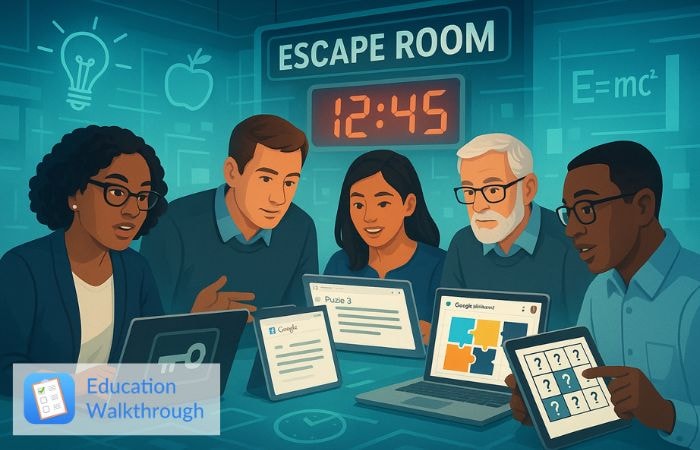
Traditional escape rooms are a go-to for building teamwork through shared challenges and time pressure.
However, digital escape rooms amplify these benefits by adding technology skills and virtual collaboration practice.
According to research on virtual team problem-solving, online escape room activities improve virtual collaboration skills by 43% and increase comfort with digital team tools by 38%.
Consider these platforms for a more engaging experience:
- Breakout EDU: Education-specific platform with teaching-related scenarios
- Escape the Room: Professional-quality virtual experiences
- Google Forms + puzzles: DIY approach using familiar school technology
- Zoom breakout rooms + shared documents: Collaborative problem-solving spaces
Time commitment: 60-90 minutes including debrief
Group size: 4-6 people per room (multiple rooms for larger teams)
Materials needed: Video platform, puzzle links, shared document access
Education-themed escape room scenarios:
- “Save the School Budget”: Solve financial puzzles to prevent devastating cuts
- “The Missing Lesson Plans”: Decode clues to recover essential teaching materials
- “Principal Lockdown”: Collaborative problem-solving during emergency scenario
- “Technology Takeover”: Solve tech-related puzzles to restore school systems
- “Student Success Mission”: Work together to unlock strategies for struggling learners
Virtual collaboration elements that build real skills:
- Shared digital workspaces: Google Docs, Jamboard, or Miro for collaborative note-taking
- Communication challenges: Some clues require verbal description of visual elements
- Resource sharing: Teams must distribute digital tools and information efficiently
- Time management: Virtual time pressure mirrors real classroom urgency
Advanced facilitation techniques:
- Multiple difficulty levels: Different puzzle complexities for mixed-experience teams
- Real-time hints: Facilitator provides graduated support through private messages
- Cross-room collaboration: Some puzzles require information sharing between breakout rooms
- Debrief connections: Explicit discussion of how virtual collaboration translates to teaching practice
Skills that transfer to virtual teaching:
- Digital tool proficiency: Comfort with multiple online platforms simultaneously
- Remote communication: Clear verbal and written instruction in virtual environments
- Collaborative problem-solving: Working through challenges without physical presence
- Technology troubleshooting: Adapting when digital tools don’t work as expected
20. Mindfulness Breaks: Virtual Calm

Again, virtual meetings can be neurologically exhausting in ways that in-person meetings aren’t.
Therefore, mindfulness breaks don’t just simulate a feel good experience, they are actually a cognitive restoration approach that improves subsequent collaboration.
That’s why research from Stanford University on Zoom fatigue shows that brief mindfulness interventions reduce virtual meeting fatigue by 58% and improve attention and engagement in subsequent activities.
Structure that maximizes impact:
- 5-7 minute guided sessions at natural meeting breaks
- Focus on breath, body awareness, or gratitude practices
- Include options for camera-off participation
- Rotate leadership between different team members
Time commitment: 5-7 minutes per break, 2-3 breaks per longer session
Group size: Any number (works for intimate teams or large meetings)
Materials needed: Quiet background, optional soft music, guided script
Mindfulness techniques specifically designed for virtual environments:
- Screen break meditation: Eyes closed or looking away from camera
- Body scan for desk posture: Awareness of physical tension from computer work
- Gratitude sharing: Brief appreciation for virtual connection and flexibility
- Breathing exercises: Simple techniques that work while seated
- Progressive muscle relaxation: Release tension accumulated during screen time
To encourage more participation, consider:
- Optional camera settings: Allow people to turn off video during mindfulness
- Variety in leadership: Different voices and styles keep practices fresh
- Brief explanations: Quick rationale for why mindfulness helps virtual collaboration
- Cultural sensitivity: Respect different comfort levels with meditation practices
Advanced mindfulness integration:
- Meeting bookends: Start and end virtual sessions with brief centering
- Transition moments: Use mindfulness to shift between different agenda topics
- Stress response tools: Teach quick techniques for use during difficult conversations
- Energy matching: Adjust mindfulness practices to group energy levels
Benefits specific to virtual environments:
- Cognitive reset: Breaks the continuous partial attention that screens create
- Physical relief: Counters neck, shoulder, and eye strain from computer work
- Emotional regulation: Provides tools for managing virtual communication challenges
- Presence enhancement: Improves attention and engagement for subsequent activities
الأفكار النهائية
By now, you would have seen that these 20 team building activities aren’t just tasks, they’re tools to transform your school’s work environment, building collaboration and increasing morale.
As an ongoing process, team building unites isolated staff into a successful team, improving teachers’ work and student success.
Not sure which one to start with? Two Truths or a Memory Wall are a great start to build relationships. You can also try a Human Knot for trust or Escape Rooms for fun.
As a take home for teachers, pick one team building activity this week, and adjust based on feedback.
Let us know which of these team building sessions you’ll like to start with.
الأسئلة المتداولة
How often should we run team building activities?
Monthly sessions are a good way to maintain momentum, with quarterly intensive activities like escape rooms for deeper impact.
How do we ensure inclusivity in physical activities?
Start by offering opt-out roles, modified versions (e.g., chair yoga), and diverse tasks to respect abilities.
Can these activities work for small teams?
Yes, these activities scale for 4-8 educators, with adaptations like paired tasks for smaller groups.
How do we measure success?
To measure success, track collaboration rates, morale surveys, and student outcomes, which reflect team strength.
What if we lack time for these activities?
Start with quick team building activities like Gratitude Jar (2 minutes) and integrate others into PD days.




